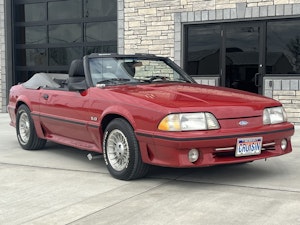Media | Articles
How historic is this Bugatti racer?
If hearing the name “Bugatti” conjures only the squat muscularity of a quad-turbo, 16-cylinder, 1,000-horsepower monster, we have a history lesson for you. Bugatti’s reputation for performance was cemented in automotive history long before it became a brand within the Volkswagen Group’s portfolio – and decades before the outrageous Veyron 16.4 arrived.
The company founded by Ettore Bugatti in 1909 earned 2,000 race victories with its Type 35 grand prix machine during its golden decade, from the mid-1920s to the mid-1930s. Its tapered form riding on eight-spoke wheels, braked via a lever on the side of the car, powered by engines of a scant 60 to 140 horsepower the Type 35 took the checkered flag at contests like the inaugural Monaco Grand Prix.
For owners like Andrew Larson, whatever early Bugattis lack by today’s standards for horsepower is offset by the thrill of wringing out a car with scrawny tires and primitive brakes around a road course at more than 100 miles an hour.
“It’s certainly a thrilling ride: no roll bar, 5-inch tires, cable brakes,” Larson said. “You have to be very careful. You push it to its limits, but carefully.”
Larson is part of a multi-Bugatti family. His late father, Karl, owned a Type 57 coupe rebodied as a 59/50B racer.
Marketplace
Buy and sell classics with confidence
The younger Larson had little interest in racing until 2006, when he recognized that the track was an opportune place to spend more time with his father, then 74. The pair raced the 59/50B at Watkins Glen International in upstate New York. The experience convinced Larson to get a Bugatti of his own. He called specialist Jim Stranberg at High Mountain Classics in Berthoud, Colo., and said, “I want to find a Bugatti.”
An eight-cylinder model would have been too expensive, Larson said, so he turned his attention to the four-cylinder models. The search turned up chassis number 37265, imported to the U.S. in 1955 by a notable Southern California sports car dealer, Otto Zipper. It passed through several owners, landing with a California restorer, Jan Voboril, in 2008. Mr. Larson bought it from Mr. Voboril.
To learn the car’s European history, Larson hired an automotive researcher, Pierre Yves Laugier, to trace the car. A rich and intricate background was unearthed, but not without some intrigue.
Laugier tracked the car from the factory through a series of owners, including a surgeon, a jeweler, a playboy and an opium baron. In 1929 the car was loaned to the famed driver Anne-Cecile Rose-Itier, who finished second at the Montrepos Hillclimb that June.
After WWII it gained the lower crankcase from the car that Baron Philippe de Rothschild had raced, and at some point it acquired a roadster body. Years later the grand prix racing body was restored to the chassis by the Bugatti specialist Bunny Phillips.
In spite of the clarity provided by Laugier, unanswered questions remain about which races the car contested and which it didn’t. These are due to confusion related to its chassis number. The car was produced in March 1927, apparently with a naturally aspirated engine. But by April its chassis number was racing in the 1927 Targa Florio as a 37A, meaning it had a supercharger.
The apparent reason, said Mr. Larson, was that Bugatti had a limited number of licenses to race. So it made a practice of removing the chassis plate from a registered car and attaching it to an unregistered car it wished to race. Since the supercharger doesn’t appear in photos until 1945, it looks as though only a small part of his car was in that race.
“The chassis plate went around the Targa Florio,” Larson said, “but my car did not.”
Today Larson said he uses as many original parts as possible but has conceded to a few modifications. For instance, there’s a four-inch extension for the steering column to accommodate his knees. “I’m six-foot-two,” he said. “I don’t think the French guys were quite that tall.”
He also had padding removed from the seat to make more room in the cockpit. After inspecting the original wheels, he decided to race on replicas as a safety precaution. He has added a magneto and changed the carburetor to run methanol fuel on the racetrack. “I’ve actually been beating the eight-cylinder cars.”
The one obvious departure from the original is the paint. Number 37265 is now white, rather than Bugatti’s French Blue. Larson’s suspicion is that the first U.S. owner, Otto Zipper, painted the car white, which is the national color both for Germany and the U.S. “I thought long and hard about painting it Bugatti blue,” Larson said. “In the end I decided not to do it.”
“Since it was painted white in the ’60s,” he said, “the car has more history in the white than in the blue.”
20170726011255)









